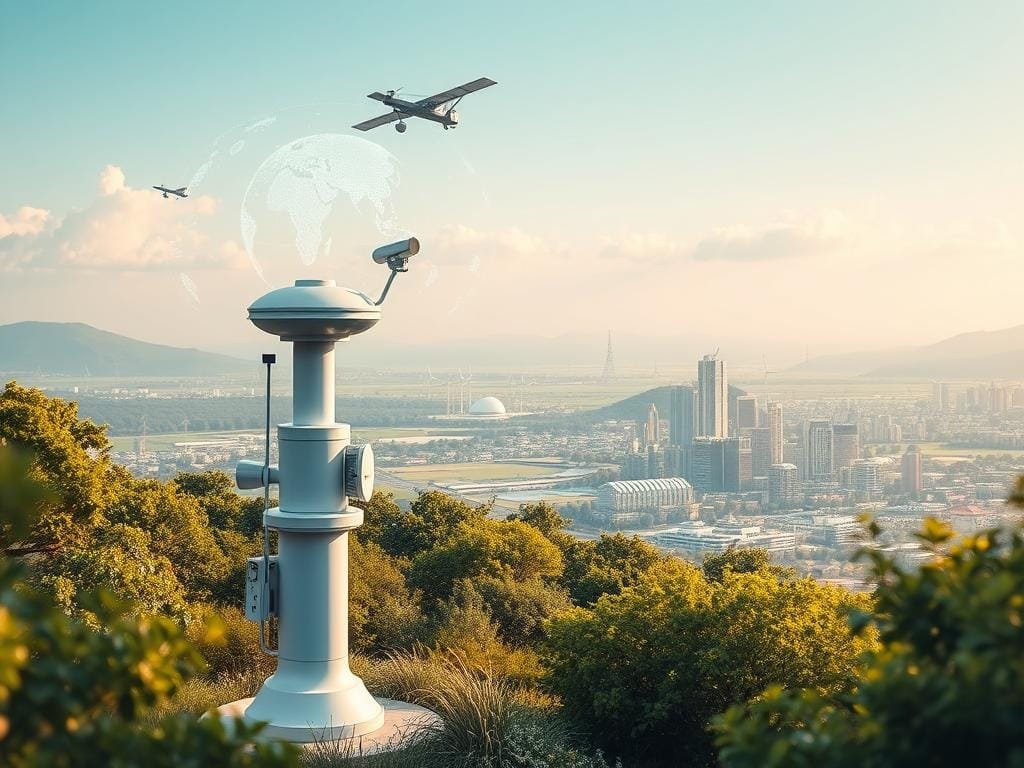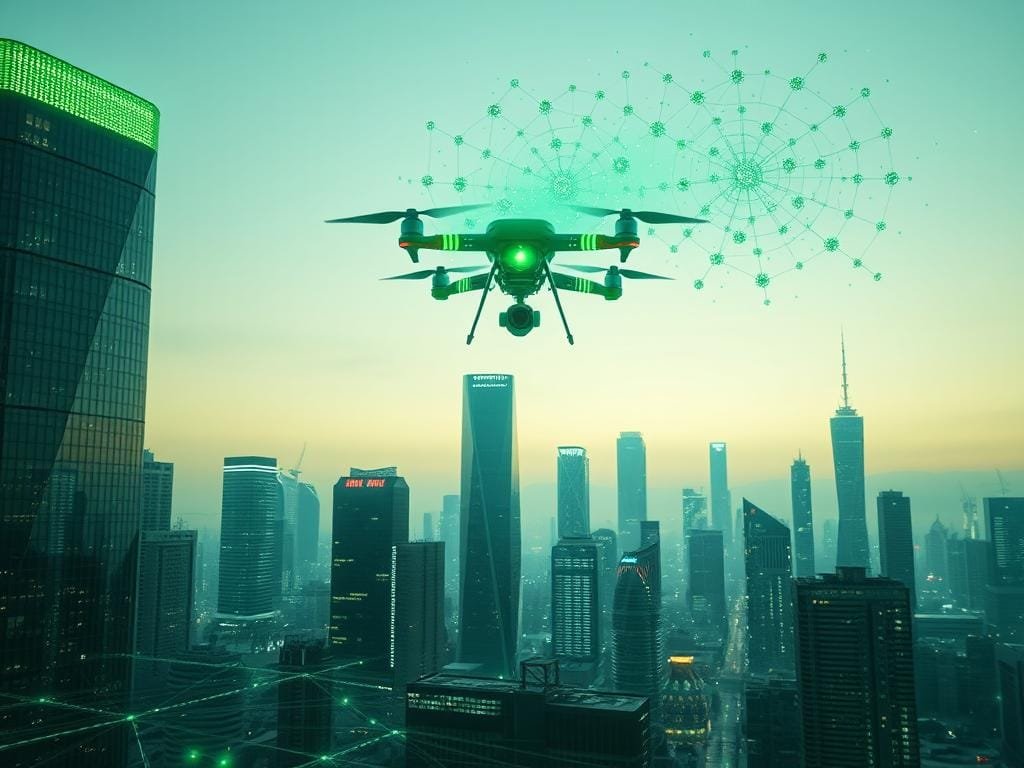Key Takeaways
- The role of AI in making sustainability efforts better across many areas.
- The power of green tech algorithms in pushing for eco-friendly ideas.
- The effect of eco-conscious machine learning on lessening environmental damage.
- The importance of sustainable artificial intelligence in supporting a circular economy.
- The future of environmentally friendly AI in fighting climate change.
The Environmental Crisis and Technology’s Dual Role
Technology plays a big role in the environmental crisis. On one side, it uses a lot of energy, making things worse. But, it also offers solutions to fight climate change.
Current Climate Challenges Facing Our Planet
The world faces big problems from climate change, like rising sea levels and extreme weather. We need to act fast. Using eco-friendly technology is key to reducing our carbon footprint and supporting sustainable living.
The rise in AI use is leading to more energy needs. This energy often comes from fossil fuels, which increases greenhouse gases and speeds up climate change.
How Technology Contributes to Carbon Emissions
Building and running tech like data centers and hardware creates a lot of carbon emissions. For example, training big AI models uses a lot of energy, often from non-renewable sources. This makes tech companies‘ carbon footprint bigger and keeps us dependent on fossil fuels.
To see how AI and climate change are connected, check out The Bigger Picture of Climate Change and AI.
The Potential for Tech-Driven Solutions
Technology is a source of hope. New tech in renewable energy and circular economy is leading to a greener future. AI and other tech can help us lower our environmental impact and grow sustainably.
AI can help make data centers more energy-efficient, predict energy needs, and improve renewable energy. By using these technologies, we can make the tech industry more eco-friendly.
What Makes Green AI Different from Conventional AI
Green AI is a new way to make AI systems. It aims to reduce their harm to the environment. Unlike regular AI, Green AI balances tech progress with caring for our planet.
The Core Principles of Green AI
Green AI focuses on sustainable computing practices. It tries to lessen AI’s harm to the environment. The main ideas are:
- Creating AI models that use less energy
- Using green data processing methods
- Designing algorithms that need fewer resources
These ideas help make AI that’s good for innovation and the planet.
Measuring and Reducing AI Carbon Footprints
It’s key to measure and cut AI’s carbon footprint. This means:
- Doing detailed energy checks on AI systems
- Using energy-saving tech and software
- Improving AI models to use less power
By doing these things, companies can lessen AI’s environmental harm. This helps make the tech world more eco-friendly.
In short, Green AI is a hopeful direction for tech. It lets us make eco-friendly AI solutions that help both tech and the planet.
How to Assess Your Current Tech Environmental Impact
Understanding your tech’s environmental impact is key to a greener future. As tech use grows, so does the need to lessen its harm on the planet.
Conducting a Technology Energy Audit
A tech energy audit checks how much energy your tech uses. It looks at data centers, servers, and devices. To do a good audit, follow these steps:
- Find all parts of your tech setup
- Track their energy use over time
- Look for ways to use less energy
This helps you see how efficient your tech is and where you can improve.
Identifying High-Impact Systems
Some tech systems use more energy than others. Data centers and cloud services are big energy users. Knowing which systems use the most energy helps you focus on making them greener. Look at:
- Data storage and processing places
- Network gear like routers and switches
- Devices like computers and phones
By focusing on these, you can cut down your environmental impact a lot.
Setting Realistic Sustainability Benchmarks
After checking your tech’s impact and finding big users, set goals for being greener. These goals should be clear, measurable, and achievable. For example, you might aim to:
- Use 20% less energy in two years
- Use renewable energy for 50% of data centers in three years
- Make your computing carbon neutral with better tech
Having clear goals helps you make your tech more eco-friendly over time.
In summary, knowing your tech’s environmental impact is vital for a sustainable future. By doing a detailed energy audit, finding big users, and setting goals, you can make your tech greener and help the planet.
Designing Energy-Efficient AI Models
The quest for sustainability in tech starts with designing AI models that use less energy. AI’s growth in capability and application raises environmental concerns. Eco-friendly AI solutions are essential for reducing tech’s carbon footprint.

Model Compression Techniques You Can Implement Today
Model compression is a key way to make AI models more energy-efficient. Techniques like pruning, quantization, and knowledge distillation reduce the resources needed. For example, pruning removes unnecessary neurons and connections, cutting down energy use.
To learn more about green AI, visit Hyscaler’s insights on revolutionary green AI.
Quantization reduces model weights’ precision, leading to faster and lower energy computations. By using these techniques, developers can create green machine learning models that are efficient and effective.
Selecting Efficient Architectures for Your Projects
Choosing the right AI architecture is key for sustainable computing. Some architectures are more energy-efficient than others. For instance, architectures that use sparse data representations can cut down on computational overhead.
When designing AI projects, consider the energy implications of your choices. Opt for architectures that balance performance with energy efficiency.
Testing and Measuring Performance vs. Energy Use
To ensure AI models are energy-efficient, test and measure their performance against energy use. Set up energy consumption benchmarks and evaluate how different models and techniques affect energy use. This helps identify the most sustainable computing practices for your applications.
In conclusion, designing energy-efficient AI models is a complex task. It involves using model compression techniques, selecting efficient architectures, and testing energy consumption. By adopting these strategies, you can help create eco-friendly AI solutions for a sustainable future.
Powering Your Tech with Renewable Energy Sources
Renewable energy is now essential for our modern tech. As we need more data storage and processing, we must find sustainable energy. This is key for our tech infrastructure.
Switching to renewable energy is vital for reducing your tech’s carbon footprint. Moving data centers to solar power is a smart move. Data centers use a lot of energy, and solar is a clean, affordable option.
Transitioning Data Centers to Solar Power
Using solar energy can greatly cut down your data center’s energy use. This lowers costs and helps the planet. Big names like Google and Microsoft are already using solar for their data centers.
Implementing Wind Energy Solutions
Wind energy is also a good choice for powering your tech. Wind turbines can power data centers and offices. It’s important to figure out the best mix of energy for your needs.
Creating Resilient Hybrid Energy Systems
For the best results, mix different renewable energy sources. For example, use solar during the day and wind at night. This ensures a steady energy supply and uses renewable resources well.
By using renewable energy and hybrid systems, you can lessen your tech’s environmental harm. This move is essential for carbon neutral computing and environmental AI solutions.
Developing Hardware Systems with Sustainability in Mind
As technology gets better, making hardware systems that are good for the planet is key. We need to use methods that cut down on harm to the environment from start to finish.

Selecting Eco-Friendly Materials and Components
Choosing eco-friendly materials and components is a big step in making sustainable hardware. This means picking materials that can be recycled, are safe, and come from sources that care about the environment. Using these materials helps lower the harm your hardware can do to the planet.
For example, using recycled metals in circuit boards and other parts can save resources and cut down on waste. Also, picking parts with little packaging or those that break down naturally can help even more.
Extending Hardware Lifecycle Through Design
Designing hardware to last longer is also important for sustainability. This means making things that are tough, can be fixed, and can be updated, so you don’t have to replace them often. This way, you can reduce the amount of trash from old electronics and lessen the harm to the environment.
Using modular designs is a smart way to do this. Modular designs make it easier to upgrade and fix things, so you don’t have to throw away the whole system because of one broken part.
Implementing Proper E-Waste Management Protocols
Even with sustainable designs, we will always have electronic waste (e-waste). So, it’s vital to have good plans for handling e-waste. This includes programs for taking back old electronics, recycling, and safe ways to get rid of them when they’re done.
For more on how to make tech more sustainable, check out our article on Green AI: A Sustainable Approach to Artificial Intelligence. It talks about how to make technology better for our planet.
Leveraging Green AI for Smart Grid Optimization
Green AI is changing how we manage and distribute energy. It uses sustainable artificial intelligence to make energy use better, cut down on waste, and help the planet.
Building AI Models for Energy Distribution
To better manage energy, we need AI models that guess energy needs and adjust supply. These models look at past data, weather, and more to make good guesses. For example, Cyient’s work on energy grid optimization shows AI’s power in making energy distribution more efficient.
- Analyze historical energy consumption data
- Integrate weather forecasts into your predictive models
- Adjust energy supply in real-time based on demand
Creating Demand Response Systems
Demand response systems help control energy use during busy times. AI-driven systems encourage people to use less energy, easing the grid’s load. Key strategies include:
- Implementing time-of-use pricing to encourage off-peak energy consumption
- Using AI to predict peak demand periods and adjust supply
- Developing smart grid technologies that can automatically adjust energy distribution
Developing Real-Time Grid Management Tools
Real-time grid management is key for stable and efficient energy distribution. AI-powered tools let us watch the grid, spot problems, and make smart choices to improve energy flow.
Real-time grid management offers many benefits:
- Enhanced grid stability and reliability
- Improved energy distribution efficiency
- Better decision-making through data analytics
Implementing AI Solutions for Climate Monitoring
AI is changing how we monitor the climate. It makes our systems more accurate and efficient. This helps us manage the environment better.

Setting Up Climate Data Collection Systems
It’s important to have good systems for collecting climate data. AI helps process data from satellites, weather stations, and sensors. This way, we can understand temperature changes, sea-level rise, and extreme weather.
These systems let us track changes in real-time. They give us data for making decisions. AI makes the process faster and less prone to errors.
Developing Predictive Models for Environmental Changes
AI is great for making predictive models. These models forecast changes like weather shifts and sea-level rise. They use past data and algorithms to predict the future.
AI models can also spot areas most at risk. This lets us focus our efforts where they’re needed most. Understanding future changes helps us plan for them.
Building Early Warning Systems for Extreme Weather
Early warning systems are key for extreme weather like hurricanes and floods. AI improves these systems by analyzing data. This way, we can alert communities at risk in time.
These systems help us respond quickly and plan for the future. AI makes us better at anticipating and dealing with extreme weather. This makes communities more resilient to climate change.
Creating Circular Economy Tech Solutions
Circular economy tech is changing how we think about sustainability in tech. It helps companies cut down on waste and make tech more eco-friendly. This is good for our planet.
Designing for Disassembly
Designing products to be easily taken apart is key in a circular economy. It lets us reuse and recycle parts better, cutting down on waste. Companies should aim for modular designs and use standard connectors to make disassembly simple.
By doing this, tech companies can lower their environmental impact. They can also make money by selling refurbished parts. This sustainable approach is becoming more important as people and governments want greener tech.
Materials Recovery Processes
Creating good systems for recycling materials is vital in circular economy tech. It means finding ways to get valuable materials back from old products. Companies can do this by investing in recycling tech and starting take-back programs.
For example, some use AI to sort recyclables better. This helps get materials like rare earth metals back, reducing the need for mining. It also cuts down on environmental harm from mining and processing.
Digital Platforms for Resource Sharing
Creating digital platforms for sharing resources is a smart move. It lets companies share things like equipment and knowledge, cutting down on waste. This is a big step towards a more circular economy.
To learn more about AI and circular economy, check out Moeveglobal’s insights. They share how tech and sustainability come together.
Using digital platforms helps companies work together and innovate. This leads to new tech solutions that are better for the planet. It also opens up new business chances in green tech.
Learning from Industry Leaders in Green Technology
Exploring green technology means learning from the best. Companies like Google and Microsoft are leading the way. They use green AI and sustainable methods to cut down their environmental impact.
Google’s Carbon-Neutral Computing Strategies
Google is a pioneer in carbon-neutral computing. They make their data centers more energy-efficient and invest in renewable energy. This has greatly reduced their carbon footprint.
- They use machine learning to cut down energy use in data centers.
- They invest in renewable energy to power their operations.
- They use advanced cooling systems to save energy.

Microsoft’s Planetary Computer Approach
Microsoft’s Planetary Computer is a great example of green technology. It aims to create a digital platform for environmental data management. This helps organizations make more sustainable choices.
- It uses advanced data analytics for environmental monitoring.
- AI-driven insights help make sustainable decisions.
- It integrates with existing environmental datasets.
Breakthrough Innovations from Sustainable Tech Startups
Sustainable tech startups are also key players. They develop innovative solutions to environmental challenges. Here are some examples:
| Startup | Innovation | Impact |
|---|---|---|
| ClimateOS | AI-powered climate risk management | Helps businesses adapt to climate change |
| Ecobloom | Sustainable urban agriculture solutions | Promotes local food production and reduces carbon footprint |
| Greenlytics | Advanced environmental data analytics | Enables data-driven sustainability decisions |
Learning from these leaders and startups helps organizations adopt sustainable practices. The future of green technology looks promising, thanks to eco-conscious machine learning and sustainable artificial intelligence.
Measuring and Reporting Your Environmental Impact
The journey to sustainability starts with knowing your current environmental footprint. As more organizations use environmental AI solutions and eco-friendly machine learning, tracking and reporting your impact is key.
Setting Up Carbon Tracking Systems
To measure your environmental impact, setting up a carbon tracking system is vital. This means watching your energy use, greenhouse gas emissions, and other environmental data. Using green data processing helps you understand your environmental footprint better.
Carbon tracking systems spot inefficiencies and offer insights to boost sustainability. You can use this data to make your operations greener, cut waste, and adopt more earth-friendly artificial intelligence.
Choosing the Right Sustainability Metrics
Picking the right sustainability metrics is essential for accurate environmental impact assessment. These can include energy use, water consumption, waste, and greenhouse gas emissions. By focusing on the most important metrics, you get a full picture of your environmental impact.
- Energy consumption per unit of production
- Greenhouse gas emissions (Scope 1, 2, and 3)
- Water usage and conservation efforts
- Waste reduction and recycling rates
Creating Transparent Environmental Reports
Being transparent is vital for trust and showing your commitment to sustainability. Detailed environmental reports show your progress and goals. These reports must be accurate, complete, and easy for your audience to understand.
By sharing environmental reports regularly, you highlight your successes, spot areas for betterment, and build a sustainable culture. This openness also helps stakeholders make informed choices and supports your sustainability goals.
Conclusion: Becoming Part of the Green Tech Revolution
You can lead the green tech revolution by supporting sustainable tech and eco-friendly tech. Companies like Google and Microsoft are using green AI to cut down on pollution. Google cut its data center energy use by 40% with AI cooling systems. Microsoft’s AI tools help companies lower emissions and waste.
By choosing renewable energy and eco-friendly practices, you can help tech innovation grow. AI is changing our world, from better delivery routes to tracking climate changes. For example, Amazon uses AI to save fuel and cut emissions. The European Space Agency uses AI to track climate changes with satellite data.
To join the green tech movement, start by checking your tech’s environmental impact. Look into green AI and sustainable tech to help our future. Learn more about AI’s role in sustainability from experts on LinkedIn.
FAQ
What is Green AI, and how does it differ from conventional AI?
Green AI focuses on making AI systems more energy-efficient and sustainable. It aims to reduce environmental harm. Unlike traditional AI, Green AI tries to cut down its carbon footprint and support green practices.
How can I assess the environmental impact of my current tech infrastructure?
Start by doing a technology energy audit. Look for high-impact systems and set goals for sustainability. This will show you where you can save energy and improve.
What are some strategies for designing energy-efficient AI models?
Use model compression and pick efficient architectures. Test how well they work while using less energy. These steps can make AI models more energy-friendly without losing performance.
How can I power my tech infrastructure with renewable energy sources?
Move data centers to solar power and use wind energy. Create systems that use both. This cuts down on fossil fuel use and supports green energy.
What are some best practices for developing hardware systems with sustainability in mind?
Choose materials and components that are good for the environment. Design systems to last longer and manage e-waste properly. This reduces waste and supports green tech.
How can Green AI be used for smart grid optimization?
Use AI to improve energy distribution and create systems that adjust to demand. Develop tools for managing the grid in real-time. This optimizes energy use and supports sustainability.
What is the role of AI in climate monitoring and prediction?
AI helps by setting up systems to collect climate data and predict changes. It also builds early warning systems for extreme weather. This enhances climate monitoring and supports sustainability.
How can I measure and report my environmental impact?
Use carbon tracking systems and pick the right metrics for sustainability. Create clear reports on your environmental impact. This shows your footprint and encourages transparency and sustainability.
What are some examples of industry leaders in green technology?
Leaders include Google, Microsoft, and green tech startups. They innovate in eco-friendly tech, renewable energy, and sustainable practices.
How can I contribute to the green tech revolution?
Adopt sustainable practices and support eco-friendly tech. Drive innovation in the tech world. This helps create a greener future and reduces our environmental impact.
What are the benefits of using environmentally conscious AI technology?
It reduces energy use and lowers carbon emissions. It also promotes sustainable practices. This makes AI systems more eco-friendly and supports a sustainable future.
What is the significance of green computing algorithms in sustainable tech innovations?
Green computing algorithms are key for sustainable tech. They make systems more energy-efficient and reduce waste. This drives sustainability in tech and helps our planet.
